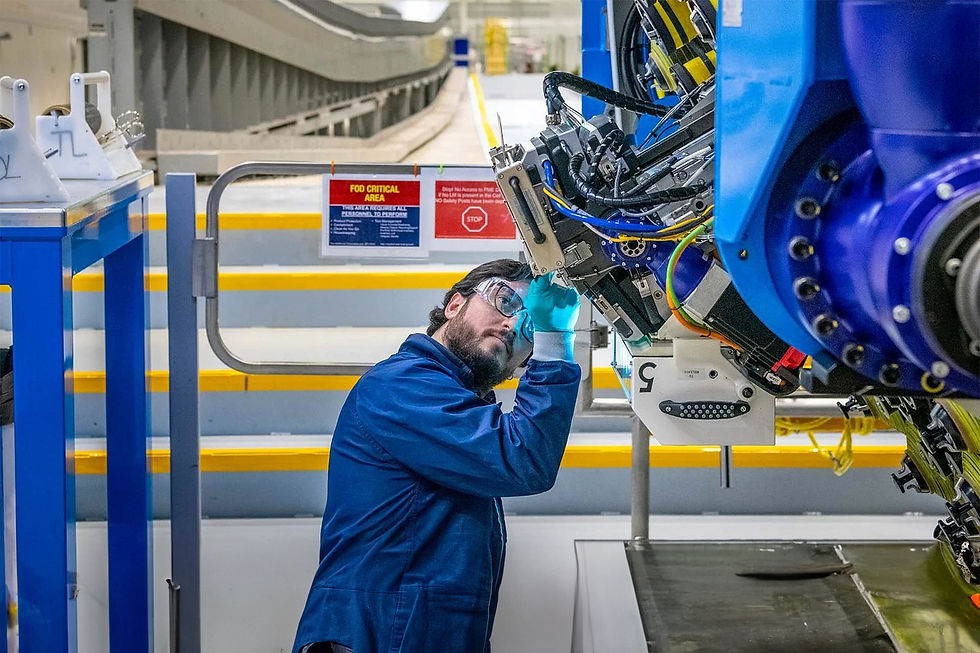A Spar is Born: Team Builds First 777-8 Freighter Wing
- Garth Calitz
- Jul 15
- 3 min read

The production of major assemblies for the 777-8 Freighter has commenced at Boeing and with key suppliers, including Mitsubishi Heavy Industries, Kawasaki Heavy Industries, and Subaru, in preparation for the first delivery scheduled for 2028.

Technicians operating an automated fibre placement machine have successfully laid down plies of composite material to construct the first spar, a crucial load-bearing beam, for the initial 777-8 Freighter wing. Additionally, the team has produced skin panels and stringers for the wings, which, along with the spars, provide the wings with their strength and shape.


“We’re excited to be building wings for the new freighter and see this program succeed,” said Dan Truong, process centre leader. “I’m looking forward to seeing the aircraft fly, knowing we contributed.”

Engineers have finalised over 80% of the drawings that outline the configuration of the 777-8 Freighter and are progressing with the detailed design of systems and components. Additionally, teams are conducting laboratory tests on systems to verify that their performance meets the intended specifications.

“Customers have a definite preference to choose Boeing – Boeing’s family of freighters serve 90% of the global freighter market,” said Ben Linder, 777 and 777-8 Freighter chief project engineer. “We’ve earned that, and customers are counting on us to deliver the first 777-8 Freighter to expand their operations and replace retiring 747-400 Freighters.”

The payload capacity of the 777-8F is comparable to that of similar aircraft. The new twin jet offers a 30% reduction in fuel consumption and emissions, a 25% improvement in operating costs per tonne, and a 60% reduction in noise footprint. According to Boeing's recently published 2025 Current Market Outlook, the global freighter fleet is expected to grow by two-thirds by 2044, which includes approximately 885 large wide-body freighters, such as the new 777-8 Freighter.

The 777X family, which includes the 777-9, the 777-8 Freighter, and the 777-8 passenger aircraft, represents the latest advancements in Boeing's renowned line of widebody aircraft. These new models are designed to meet the evolving demands of the aviation industry while providing enhanced efficiency, performance, and passenger comfort.

The 777-9 is the largest variant of the 777X family and is engineered to accommodate a significant number of passengers, making it ideal for long-haul routes. With a seating capacity of approximately 426 passengers in a typical two-class configuration, the 777-9 is designed to provide airlines with the ability to optimise their operations on high-demand routes. Its advanced aerodynamics, coupled with the latest generation of GE9X engines, allows the aircraft to achieve impressive fuel efficiency, reducing operating costs while also lowering its environmental impact. The wingspan of the 777-9 features innovative folding wingtips, which enhance aerodynamic performance and allow for compatibility with existing airport gates, making it a versatile choice for airlines.

The 777-8 Freighter is specifically tailored for cargo operations, offering a substantial payload capacity and the ability to transport large volumes of goods over long distances. This freighter variant is designed to meet the needs of global supply chains, providing airlines and logistics companies with a reliable solution for air freight. The 777-8 Freighter incorporates the same advanced technologies as its passenger counterparts, ensuring fuel efficiency and reduced emissions. With a maximum payload capacity of around 118,000 pounds, it is capable of carrying a wide variety of cargo, from perishables to heavy machinery, making it a versatile asset in the air cargo market.





























Comments